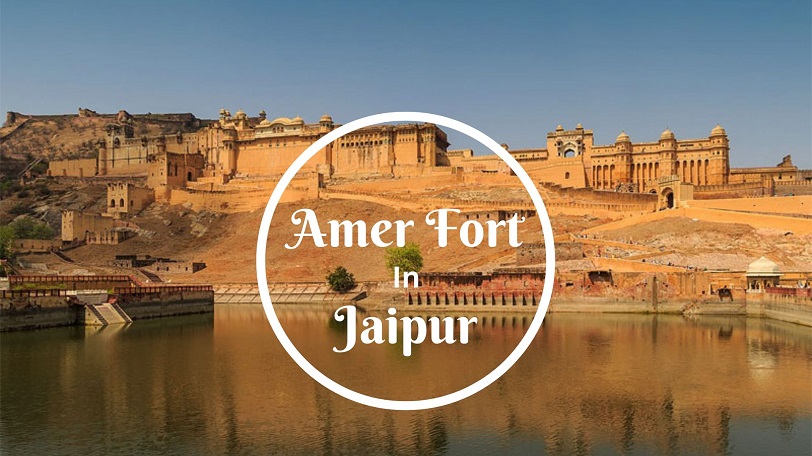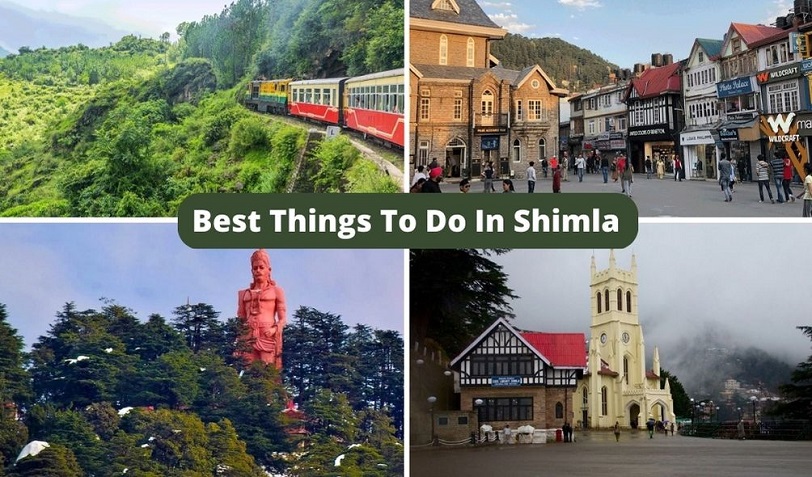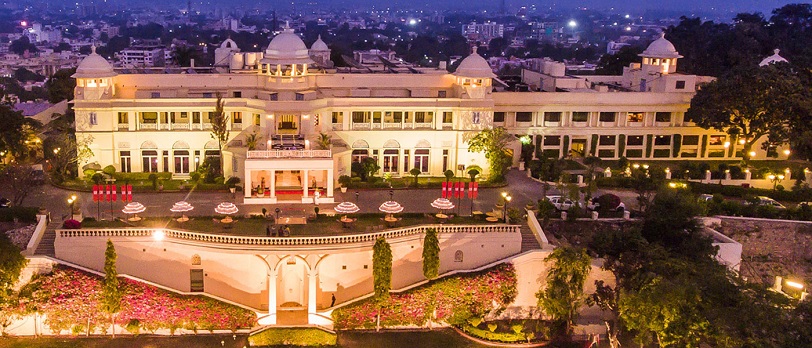The vibrant city of Jaipur welcomes people from across the world. Home to several historic landmarks, bustling markets, amazing cuisines, and splendid architecture, Jaipur is culturally rich and historically abundant. Whether you like to learn about the history of the place or are interested in arts and architecture, Jaipur will leave you with unforgettable experiences. Some of the city’s most famous and regal attractions include Jantar Mantar, Nahargarh Fort, City Palace, Hawa Mahal, Albert Hall Museum, and Birla Mandir.
Each attraction of Jaipur holds its own importance and significance; however, the magnificence of Amer Fort remains unmatched. The grand structure, also often called Amber Fort, is a part of the five other forts of the region which were inducted into the UNESCO World Heritage Site list of the “Hill Forts of Rajasthan.” The opulent fortress is located approximately 11km from Jaipur and perched on a hilltop that can be reached via car.
- Location: Devisinghpura, Amer, Jaipur
- Timings: 8:00 AM to 6:00 PM
- Entry Fee
Foreigners: INR 550 per person, Foreign Students: INR 100 per person, Indians: INR 50 per person, Indian Students: INR 10 per person - Best Time To Visit: October To March
Amer Fort: History

Priorly a small town, Amer Fort’s history can be traced back to 967 C.E. when the ruler of the Chanda clan of Meenas started building the fortress and settling the city. In the year 1952, Raja Man Singh of the Kachwaha clan and one of Akbar’s Nine Jewels started building the fort over the old one, and the baton for its expansion was carried forward by Raja Jai Singh I and other successors of the ruler.
During the rule of the Kachwaha clan, which lasted from the 11th to the 16th century, the fort underwent several renovations and expansions, which were ultimately stopped once the capital was shifted from Amer to Jaipur.
The name of the fort also has an interesting story behind it. The fort is said to have been named after Ambikeshwar, which is another name for Lord Shiva however, the locals also believe that the name has its roots in the name Amba which is the second name for Goddess Durga.
Also Read: Best Forts In Jaipur
Amer Fort: Architecture
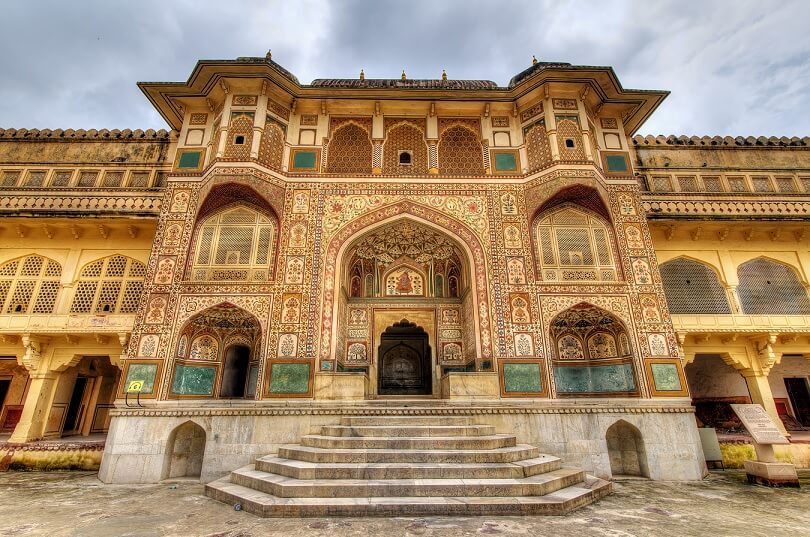
Build in classic Mughal and Rajput architectural styles, Amer Fort is made of red sandstone and marble. The fort overlooks Maota Lake, once the main water source, and beautifully landscaped gardens that further enhance the regal structure.
The main entrance to the fort is called Suraj Pol, which leads to the widespread courtyard. Divided into four parts, each of which has its own adorned entrance and courtyard, the fort has several stunning staircases and alleyways. The intricate paintings of Hindu Gods and goddesses on the walls are also a major attraction of Amber Fort Jaipur.
Siladevi Temple is on the right side from the main entrance, and the other side leads to the main palace complex, which is preceded by an expansive courtyard called ‘Jaleb Chowk’. The public audience hall called Diwan-E-Am is present on the second floor of the palace and is decorated with elaborate mosaic glasswork and supported by two pillars mounted with elephants. The third part of the fort is the royal quarters which is reached through the courtyard named ‘Ganesh Pol’. Other parts of the palace include ‘Sheesh Mahal’, one of the best attractions of the fort as it has beautiful carvings and glass paintings, and ‘Sukh Mahal’, which is made up of ivory and sandalwood.
Other features of the fort include a quarter for royal women, which is surrounded by a courtyard and a hall called the Jas Mandir.
Amer Fort: Attractions
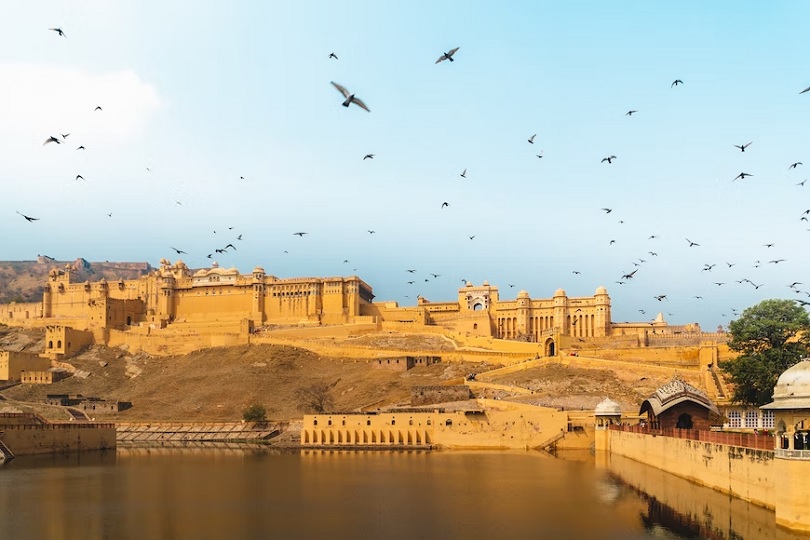
Some of the main attractions of Amber Fort include:
- Suraj Pol: The main entry gate, Suraj Pol has a zig-zag design that serves as a backdrop in Bollywood movies. You can even take an elephant ride to get here.
- Jaleb Chowk: A vast courtyard that served as the gathering place for soldiers back in the day, Jaleb Chowk is the main courtyard and is home to the renowned Shila Devi Temple.
- Sheesh Mahal: One of the best attractions of the fort, Sheesh Mahal is replete with intricate paintings and glasswork. A candle lighted in the middle of this structure gives an illusion of a starry night.
- Ganesh Pol: An artistic marvel, Ganesh Pol is the main gate of the palace and undoubtedly the most Instagram-able one.
- Deewane- E-Am: The public audience hall, Deewana-E-Am, is located opposite Ganesh Pol and it is the location where the king heard the grievances of the audience.
- Jai Mahal: Jai Mahal in itself has two main spots, namely – Deewane- E- Khas and Jai Mandir. Deewane-E-Khas is home to the famous ‘Magic Flower’, which has a delicately carved structure of Lord Ganesha; carved out of a single coral. Jai Mandir is the other section that had a bath house.
- Light and Sound Show: An exciting event showcasing the history of the fort and Jaipur too, the Light and Sound Show at Amer Fort is truly a sight to behold.
Also Read: Best Places To Visit In Jaipur
Entry Details
Amer Fort is open for visitors every day from 8 AM to 6 PM. If you wish to watch the light and sound show, you will have to wait till 7.30 PM for the English show and till 8.30 PM for the Hindi show. The show lasts 50 minutes, and the ticket is INR 295/- per person. You will require a minimum of 4 hours to tour the complete fort, and the months ranging from October to February are the best ones to visit the fort and Jaipur itself.
As you plan to explore the grandeur of Amer Fort, book your stay with us at The LaLiT Jaipur. As one of the leading 5 star hotels in Jaipur, our exceptional hospitality awaits you in the Pink City with top-notch facilities and luxuries unlike any other.
